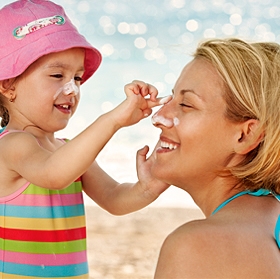Article at a Glance
A recent study suggests that protecting your children now from sun exposure is the best way to prevent melanoma later. Melanoma is the least common form of skin cancer, but it is also the deadliest.
According to the study, sun exposure throughout a person’s life can contribute to non-melanoma skin cancers, but melanoma was strongly tied to sun exposure during our early years.
The study followed 108,916 Caucasian, female nurses for about 20 years—tracking things like sun exposure, tanning bed use, family history, and other risk factors. Those who reported suffering 5 or more blistering sunburns when they were between 15 to 20 years old were 80 percent more likely to get melanoma. This same group had a 68 percent increase of squamous cell carcinoma (SCC) and basal cell carcinoma (BCC) of the skin.
Higher levels of UV exposure when they were older did not increase the risk for melanoma, but there was a 2.35-fold and 2.53-fold increase for developing BCC and SCC of the skin.
“Parents may need to be advised to pay more attention to protection from early-life sun exposure for their kids in order to reduce the likelihood of developing melanoma as they grow up. Older individuals should also be cautious with their sun exposure, because cumulative sun exposure increases skin cancer risk as well,” advises Abrar A. Qureshi, M.D., MPH, professor and chair of the Department of Dermatology at Warren Alpert Medical School of the Brown University and Rhode Island Hospital in Providence.
The American Academy of Pediatrics recommends that children under 6 months old stay out of direct sunlight and dress in lightweight clothing that covers their arms and legs. If you can’t keep your baby in the shade, you should apply sunscreen made for infants. Before using any sunscreen, test it on your baby’s back to make sure they don’t have a reaction.
For older children, a sunscreen with at least SPF 15 should be applied every two hours or after they have been swimming or sweating.
Read more about how to protect your family from sun exposure:
Spring is a Hot Time for Sunburns
This article includes great tips on how to apply sunscreen and how to treat a sunburn.
The Sun is Not Your Friend: What You Need to Know About Skin Cancer
Did you know that Utahans have a higher than average rate of skin cancer, including melanoma?
Protect Your Children From Skin Damage
Tips on when UV rays are at their worst and other ways to reduce UV exposure.
More information:
American Association for Cancer Research
